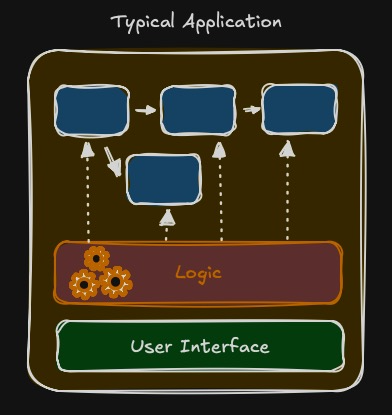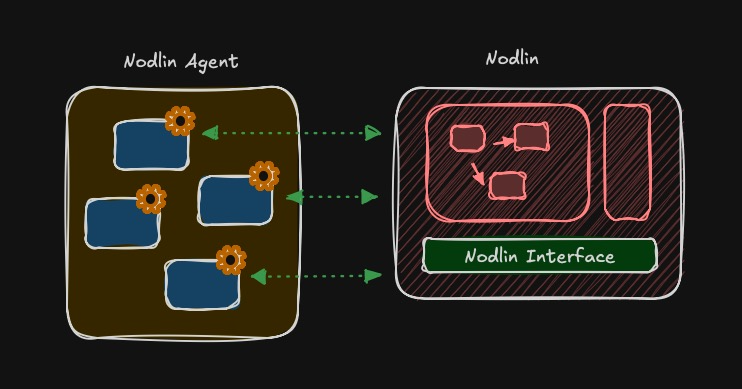The ’typical’ application model
A typical application combines an interface, business logic, and data entities (projects, requirements, tasks, budget etc.).
The logic keeps everything in sync and consistent — for example, updating a task estimate automatically rolls up to the project estimate. This maintenance of consistency is generally applied across both high volume data processing platforms (e.g. handling orders), and more user centric applications (e.g. managing tasks, budgets, requirements etc).
But this consistency comes at a cost: the application is bounded by its data model, and every update forces the user to wait. The more complexity you add, the longer the delay. This delay is generally not significant, but becomes more of an issue when this user-centric detail needs to be shared *across different applications.
Performance improvements can be applied in the application itself. Taking a spreadsheet, once they grow heavy with interdependent formulas, you switch off auto-recalc and trigger a manual recalculate only when you’re ready. A rather crude but effective approach.
The bigger issue is that applications rarely exist in isolation. A task tied to a requirement may also connect to an organisational objective, a budget, or other business entities — usually spread across different systems. Again taking the spreadsheet as an example, the information contained (or derived) is generally obtained from the wider context. The user needs to be aware of all these connections, and keep them in sync.
Over time, teams have built elaborate integration mechanisms to “sync” these data points, while others rely on imports, exports, and manual updates. The result? inconsistencies, lag in transparency, higher costs, and slower decision making.
Nodlin is different
Nodlin introduces a different model: the premise being that user centric applications are ok with eventual consistency, nodlin will handle the processing to ensure your data is brought up-to-date, aka eventually consistent. To resolve the application boundary issues you are able to connect different data elements that typically exist across different systems, and keep these in sync.
To achieve this, Nodlin organises logic around the node — the core data element being managed (e.g. a task). Nodes can connect to other nodes (e.g. a task to a project), and Nodin ensures the right logic is executed to update those relationships.
Think of it as a spreadsheet model for data nodes: each node updates as needed, and while not instantaneous, with a manageable number of nodes it feels seamless to the user.
In this model, the Nodlin agent becomes the new application — focused on a specific set of data elements, but designed to connect, extend, and integrate with other capabilities.
This approach brings new complexities — and Nodlin is built to ease the development. It represents a new way of thinking about applications: moving beyond the rigid demand for real-time consistency, and allowing data to flow more naturally across connected elements.
The result is a shift toward user-centric systems that reflect how businesses actually operate — dynamic, interconnected, and evolving. With Nodlin, information is no longer locked into isolated applications, but presented as a clear, living view of your business.
Why Nodlin? details a more detailed rationale for this approach.
"This is a new way of building user centric applications. Given the different performance and consistency requirements, it is a great fit for a modern business."
The ‘unbounded’ application
Nodlin is designed to let you bring your own business logic.
Agents can be built externally to access firm systems, AI services, and other data sources. To accelerate development and standardise business communication, agents can be scripted in a Python-like language.
Node logic isn’t limited to the nodes defined within an agent — it can interpret any connected node to enrich processing. Internal node types can also support workflow, notes, categorisation, and more.
With this flexibility, nodes can connect seamlessly across agents, creating an unbounded update stream across the business. No more imports, exports, or manual re-keying — just a more integrated, live view of your organisation.
"Its like having one spreadsheet that spans across all the information in your business"

